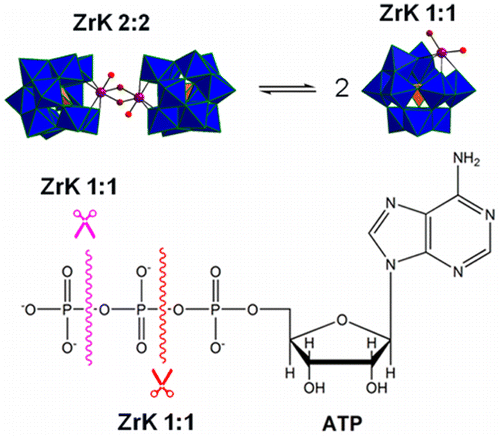当前位置:
X-MOL 学术
›
Inorg. Chem.
›
论文详情
Our official English website, www.x-mol.net, welcomes your
feedback! (Note: you will need to create a separate account there.)
Detailed Mechanism of Phosphoanhydride Bond Hydrolysis Promoted by a Binuclear ZrIV-Substituted Keggin Polyoxometalate Elucidated by a Combination of 31P, 31P DOSY, and 31P EXSY NMR Spectroscopy
Inorganic Chemistry ( IF 4.3 ) Pub Date : 2016-04-25 00:00:00 , DOI: 10.1021/acs.inorgchem.6b00385
Thi Kim Nga Luong 1 , Pavletta Shestakova 1, 2 , Gregory Absillis 1 , Tatjana N. Parac-Vogt 1
Inorganic Chemistry ( IF 4.3 ) Pub Date : 2016-04-25 00:00:00 , DOI: 10.1021/acs.inorgchem.6b00385
Thi Kim Nga Luong 1 , Pavletta Shestakova 1, 2 , Gregory Absillis 1 , Tatjana N. Parac-Vogt 1
Affiliation

|
A detailed reaction mechanism is proposed for the hydrolysis of the phosphoanhydride bonds in adenosine triphosphate (ATP) in the presence of the binuclear ZrIV-substituted Keggin type polyoxometalate (Et2NH2)8[{α-PW11O39Zr(μ-OH)(H2O)}2]·7H2O (ZrK 2:2). The full reaction mechanism of ATP hydrolysis in the presence of ZrK 2:2 at pD 6.4 was elucidated by a combination of 31P, 31P DOSY, and 31P EXSY NMR spectroscopy, demonstrating the potential of these techniques for the analysis of complex reaction mixtures involving polyoxometalates (POMs). Two possible parallel reaction pathways were proposed on the basis of the observed reaction intermediates and final products. The 1D 31P and 31P DOSY spectra of a mixture of 20.0 mM ATP and 3.0 mM ZrK 2:2 at pD 6.4, measured immediately after sample preparation, evidenced the formation of two types of complexes, I1A and I1B, representing different binding modes between ATP and the ZrIV-substituted Keggin type polyoxometalate (ZrK). Analysis of the NMR data shows that at pD 6.4 and 50 °C ATP hydrolysis in the presence of ZrK proceeds in a stepwise fashion. During the course of the hydrolytic reaction various products, including adenosine diphosphate (ADP), adenosine monophosphate (AMP), pyrophosphate (PP), and phosphate (P), were detected. In addition, intermediate species representing the complexes ADP/ZrK (I2) and PP/ZrK (I5) were identified and the potential formation of two other intermediates, AMP/ZrK (I3) and P/ZrK (I4), was demonstrated. 31P EXSY NMR spectra evidenced slow exchange between ATP and I1A, ADP and I2, and PP and I5, thus confirming the proposed reaction pathways.
中文翻译:

由31 P,31 P DOSY和31 P EXSY NMR光谱结合阐明的由双核Zr IV取代的Keggin多金属氧酸盐促进的磷酸酐键水解的详细机理
详细的反应机理提出了一种用于在双核Zr的存在三磷酸腺苷(ATP)的phosphoanhydride键的水解IV取代的Keggin型多金属氧酸盐(ET 2 NH 2)8 [{α-PW 11 ø 39的Zr(μ -OH)(H 2 O)} 2 ]·7H 2 O(ZrK 2:2)。31 P,31 P DOSY和31 P的组合阐明了在ZrK 2:2存在下dD 6.4时ATP水解的全部反应机理P EXSY NMR光谱,证明了这些技术在分析涉及多金属氧酸盐(POM)的复杂反应混合物中的潜力。根据观察到的反应中间体和最终产物,提出了两种可能的平行反应途径。样品制备后立即测量的20.0 mM ATP和3.0 mM ZrK 2:2混合物在pD 6.4处的1D 31 P和31 P DOSY光谱证明形成了两种类型的复合物I1A和I1B,表示不同的结合模式在ATP和Zr IV之间取代的Keggin型多金属氧酸盐(ZrK)。NMR数据分析表明,在pD 6.4和50°C下,ZrK存在下ATP的水解过程是逐步进行的。在水解反应过程中,检测到各种产物,包括二磷酸腺苷(ADP),单磷酸腺苷(AMP),焦磷酸盐(PP)和磷酸盐(P)。此外,鉴定了代表复合物ADP / ZrK(I2)和PP / ZrK(I5)的中间体物种,并证明了另外两种中间体AMP / ZrK(I3)和P / ZrK(I4)的潜在形成。31 P EXSY NMR光谱证明ATP与I1A,ADP和I2以及PP和I5之间的缓慢交换,从而证实了拟议的反应途径。
更新日期:2016-04-25
中文翻译:

由31 P,31 P DOSY和31 P EXSY NMR光谱结合阐明的由双核Zr IV取代的Keggin多金属氧酸盐促进的磷酸酐键水解的详细机理
详细的反应机理提出了一种用于在双核Zr的存在三磷酸腺苷(ATP)的phosphoanhydride键的水解IV取代的Keggin型多金属氧酸盐(ET 2 NH 2)8 [{α-PW 11 ø 39的Zr(μ -OH)(H 2 O)} 2 ]·7H 2 O(ZrK 2:2)。31 P,31 P DOSY和31 P的组合阐明了在ZrK 2:2存在下dD 6.4时ATP水解的全部反应机理P EXSY NMR光谱,证明了这些技术在分析涉及多金属氧酸盐(POM)的复杂反应混合物中的潜力。根据观察到的反应中间体和最终产物,提出了两种可能的平行反应途径。样品制备后立即测量的20.0 mM ATP和3.0 mM ZrK 2:2混合物在pD 6.4处的1D 31 P和31 P DOSY光谱证明形成了两种类型的复合物I1A和I1B,表示不同的结合模式在ATP和Zr IV之间取代的Keggin型多金属氧酸盐(ZrK)。NMR数据分析表明,在pD 6.4和50°C下,ZrK存在下ATP的水解过程是逐步进行的。在水解反应过程中,检测到各种产物,包括二磷酸腺苷(ADP),单磷酸腺苷(AMP),焦磷酸盐(PP)和磷酸盐(P)。此外,鉴定了代表复合物ADP / ZrK(I2)和PP / ZrK(I5)的中间体物种,并证明了另外两种中间体AMP / ZrK(I3)和P / ZrK(I4)的潜在形成。31 P EXSY NMR光谱证明ATP与I1A,ADP和I2以及PP和I5之间的缓慢交换,从而证实了拟议的反应途径。































 京公网安备 11010802027423号
京公网安备 11010802027423号